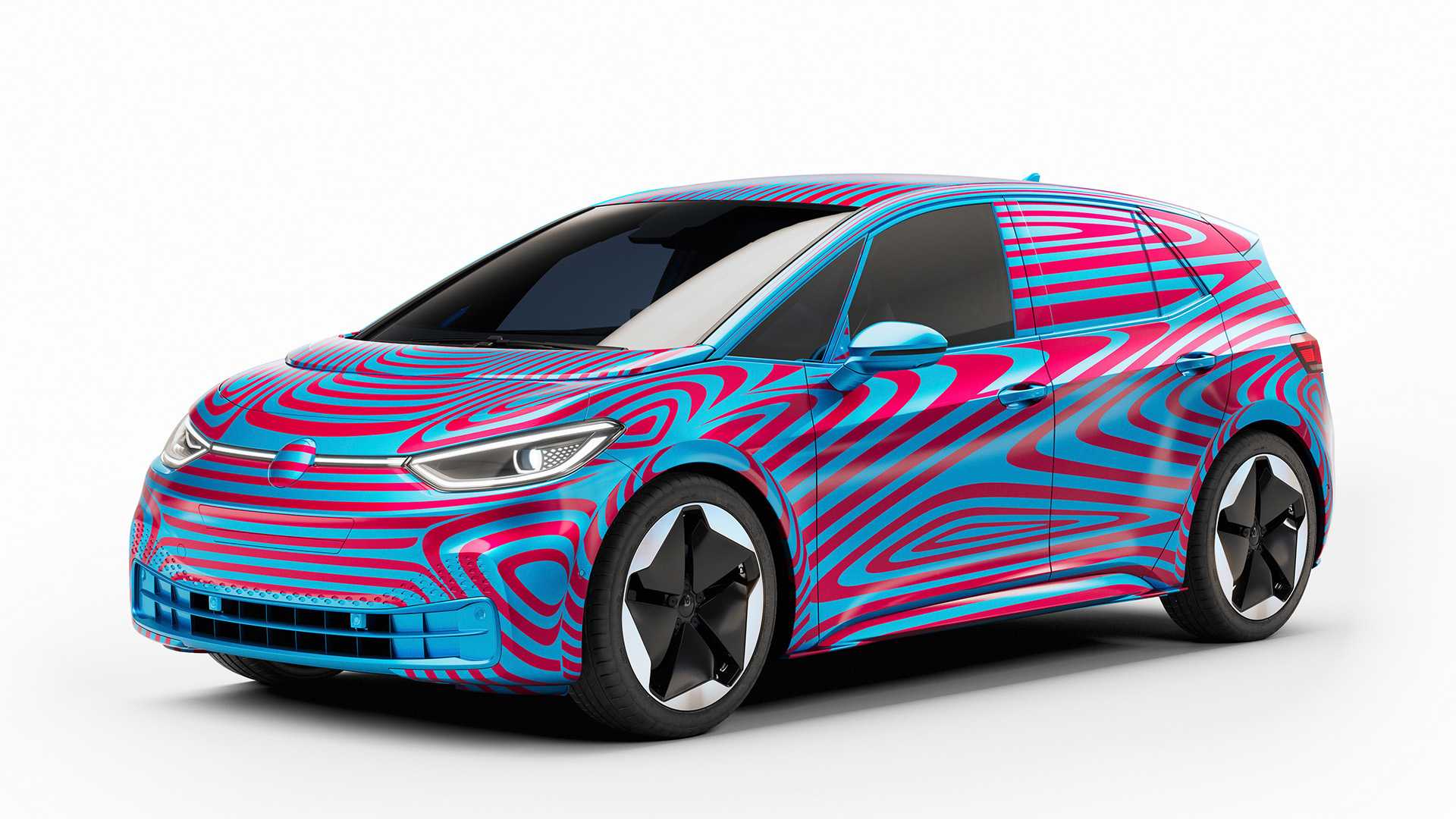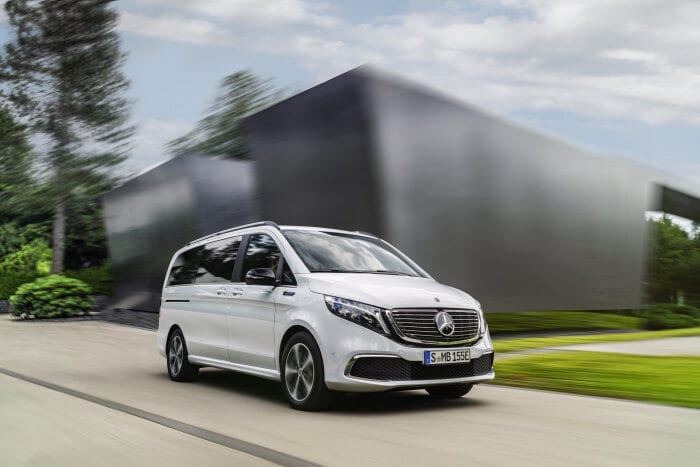20.
August 2019
Stuttgart
A range of 405 kilometres (provisional figures)[1] and a rapid charging function as standard provide electromobility for everyday use Full availability of space thanks to installation of high-voltage battery below the floor Intelligence and connectivity with MBUX and EQ-specific functions Interior and exterior design in specific EQ aesthetic Following the eVito and eSprinter, Mercedes-Benz Vans presents its first electric vehicle
that is positioned equally for private and commercial purposes Mercedes-Benz Vans presented the Concept EQV as a study at the Geneva Motor Show in March 2019. Now the series version of the Mercedes-Benz EQV (combined power consumption: 27.0 kWh/100 km; combined CO2 emissions: 0 g/km, provisional figures)1 is celebrating its debut. The next member of the Mercedes EQ family combines emissions-free mobility with impressive driving abilities, high functionality
and aesthetic design as the first fully-electric premium MPV from Mercedes-Benz. The Mercedes-Benz EQV will be displayed to the public for the first time at this year's IAA (12 to 22 September).
The technical highlights include a range of 405 kilometres (provisional figures)1 and the rapid charging of the high-voltage battery from 10 to 80 per cent in less than an hour. The Mercedes-Benz EQV also offers ultimate comfort in the interior and unparalleled flexibility. Customers can also choose between two different wheel bases.
“Our MPVs meet the highest standards in terms of functionality and variability. The EQV also does not compromise in this respect. It offers comfortable handling, dynamic electro-aesthetics, intuitive operation and generous space – and all locally emissions-free. This means that it offers all of the typical qualities of the brand and segment that our customers expect, whether as a family car or a shuttle vehicle with a lounge-like character”, says Marcus Breitschwerdt, Head of Mercedes-Benz Vans.
As a series-produced vehicle, the EQV is fully integrated into the production operations of the plant in Vitoria in northern Spain, where the V-Class and Mercedes-Benz Vito are also made. This facilitates flexible and synergetic production in direct correlation with customer demand.
Maximum benefit thanks to intelligent design
The electric drive train (eATS) of the Mercedes-Benz EQV is situated on the front axle under the dynamic front end of the car with a charging connection in the bumper. It has a peak output of 150 kW. The electric motor, the transmission with a fixed gear ratio, the cooling system and the power electronics constitute a highly integrated, compact unit. The power is provided by a lithium ion battery under the floor of the vehicle. Its low, central location also has a positive effect on the handling characteristics of the EQV. A top speed of up to 160 km/h also ensures that you quickly get to where you are going outside an urban environment.
As standard the Mercedes-Benz EQV is equipped with a water-cooled on-board charger (OBC) with a capacity of 11 kW, making it suitable for AC charging at home or at public charging stations. The battery, which has a usable capacity of 90 kWh, facilitates a maximum range of 405 kilometres (provisional figures)1. The installation of the battery in the space below the floor means that all of the space is available, with no impact on the interior of the vehicle. This means that the fully electric MPV from Mercedes-Benz also meets the highest standards in terms of functionality and variability and covers
a large number of applications. In the private sphere, for example, families benefit from a multitude of seating configurations as well as a good conscience from producing zero local emissions. Six individual seats, on the other hand, turn the Mercedes-Benz EQV into a representative shuttle vehicle that meets all of the requirements for the high-quality transportation of people with a comfortable and particularly quiet driving experience. The flexible installation of individual or bench seats also allows the EQV to be converted into a 7- or even an 8-seater.
MBUX in the EQV: electric and intelligent
The refinement of MBUX specifically for EQ is a particular highlight. In the high-resolution, 10-inch media display, the EQ tile in the main menu serves as a central point of access to the specific displays and settings. These include the charging current, departure time, energy flow and consumption histogram. The media display can also be used to operate the navigation and Mercedes me Charge functions, as well as the driving modes. One of the strengths of MBUX is its intelligent voice control with natural language comprehension, which is activated by the keyword “Hey Mercedes”. The voice control supports many infotainment functions (e.g. destination input, phone calls, music selection, writing and hearing messages, weather forecast), as well as numerous convenience functions such as climate control/lighting. And MBUX also applies its strengths in combination with the Mercedes me App outside the vehicle. EQV drivers can plan their destinations from the home or office, enter a departure time and bring the interior to the desired temperature.
Maximum range thanks to intelligent recuperation and different driving modes
To ensure that the technical operating range is used to the maximum, the Mercedes-Benz EQV also charges its batteries when on the move. When accelerating or braking, the mechanical rotation is converted into electrical energy and used to charge the high-voltage battery (recuperation). The driver has a major influence on recuperation. He/she is also able to influence the recuperation level using paddles behind the steering wheel. The paddle on the left increases the level of recuperation, the paddle on the right reduces it. At the weakest level the vehicle “coasts”, while at the strongest level it is possible to drive using a single pedal.
This is because, in most situations, the slowing effect of recuperation is sufficient to make the brake pedal redundant.
The recuperation level D Auto reflects the intelligence of the EQV. The automatically activated ECO Assistant helps the driver to achieve the best possible efficiency. It combines navigation data, road traffic sign recognition and information provided by the intelligent safety assistance systems (radar and camera), and adjusts the level of recuperation itself.
In combination with EQ-optimised navigation, active range monitoring ensures that the driver reaches the destination safely even if a charging stop is missed. It is also assisted by the E+ driving mode, which optimises the vehicle's parameters to maximise the range.
Comprehensive electromobility ecosystem with numerous charging opportunities
Part of the EQ technology brand is a comprehensive electromobility ecosystem, which the Mercedes-Benz EQV benefits from as the youngest member of the EQ family. This includes a holistic range of services, and ranges from vehicle functions such as adapted navigation through to the charging infrastructure. Via Mercedes me Charge, the customer receives access to the world's largest charging network with over 300 000 charging points and over different operators of public charging stations in Europe alone (municipalities, car parks, motorways, shopping centres, etc.). Customers benefit from an integrated payment function with simple invoicing. Mercedes me Charge also allows access to the quick-charging stations of the pan-European network IONITY. Especially over long distances, the short charging times make for a pleasant journey. By 2020 IONITY will construct and operate around 400 quick-charging stations along the main traffic arteries in Europe. IONITY was founded in November 2017 as a joint venture by BMW Group, Daimler AG, Ford Motor Company and the Volkswagen group with Audi and Porsche.
With the Mercedes-Benz Wallbox Home and 11 kW charging output, the EQV can be charged significantly faster than using a domestic socket. In cooperation with country-specific charger installation partners, Mercedes-Benz also offers easy and rapid installation of the Mercedes-Benz Wallbox and professional advice on all aspects of e-mobility. DC charging using the series-standard CCS (Combined Charging Systems) is even faster. In Europe the EQV can be charged with a maximum output of up to 110 kW at an appropriate charging station. It then takes less than 45 minutes to charge from 10 to 80 per cent SoC (State of Charge).
Design with specific EQ aesthetic
One element that all EQ vehicles have in common is their design with a specific avant garde aesthetic. The focal point is the black panel radiator grille with chrome fins, as well as the clear side profile with specific, EQ design, lightweight, 18-inch wheels, which make a dynamic impression even when stationary.
The aesthetic of the exterior is continued in the interior, where the cool aesthetic is complemented by warm accents such as rose gold, underscoring the “welcome home” effect. The heart of the interaction between driver and machine is the intuitive Mercedes-Benz User Experience (MBUX). This combines a 10-inch touch screen with learning voice operation and innovative connectivity features.
The colour rose gold, which stands for value and electrification, also plays an important role in the dashboard. And complements the midnight blue leather appearance. The design of the controls is also characteristic. Rose gold provides elegance and warmth for the infotainment and sound system, and “Silver Shadow” surrounds the air vents. Decorative stitching along the seats in rose gold provides contrast.
The Mercedes-Benz EQV as a new milestone for the “EQ” technology brand
The “EQ” technology brand founded by Mercedes-Benz in 2016 stands for the consistent ongoing development of electromobility. It all started with the “Concept EQ”. This was followed by the Concept EQA in the compact class at the 2017 IAA. In September 2018 the brand presented its first series-produced vehicle in the form of the EQC electric SUV (combined power consumption: 20.8 – 19.7 kWh/100 km; combined CO2 emissions: 0 g/km)[2]. In March 2019, the Concept EQV at the Geneva Motor Show indicated a potential expansion of the model range in the MPV segment, with up to eight seats. The series-produced version of the Mercedes-Benz EQV that has now been presented marks a new milestone in the development of the “EQ” technology brand.
Technical data
CO2 emissions
0 g/km
Electrical combined
27.0 kWh/100 km (provisional figures)1
Range
405 km(provisional figures)1
Charging time at a Wallbox or at public charging stations (AC charging, 11 kW)
Charging time at a fast charging station (DC charging, 110 kW)
10-80 % SOC in
Drive system
Front-wheel drive
Output
150 kW (204 hp)
Peak torque
362 Nm
Top speed
160 km/h
Battery
Lithium-ion
Battery energy content (installed)
100 kWh
Battery energy capacity
(usable)
90 kWh
Lengths:
5140 mm, 5370 mm
Wheelbases
3200 mm, 3430 mm
Luggage compartment (depending on equipment fitted)
1030 litres
GVW
3500 kg
[1] Figures for electrical consumption and range are provisional and were determined by the technical service for the certification according to
UN/ECE-regulation 101. EC type approval and conformity certification with official figures are not yet available. There may be differences between
the stated figures and the official figures.
[2] Power consumption and range have been determined on the basis of Regulation (EC) No. 692/2008. Power consumption and range depend
on the vehicle configuration.
Press Contact
Oliver Fenzl
Spokesperson Van Technology Communications – eDrive@Vans
oliver.fenzl@daimler.com
Tel: +49 (0)711 17-4 54 64
Fax: +49 (0)711 17-52030
Press Contact Overview
Media
Download
Pictures (31)
Videos (2)
Documents (1)
Media Contact (1)
Filter
Show thumbnails
Show list
Slideshow
Settings
Preview
Do you really want to delete the data record?
Please wait a moment …
Please wait a moment …
Please wait a moment …
Please wait a moment …
19C0643_002
Legend
:
The new Mercedes-Benz EQV – Exterior, Mountain crystal white metallic, black panel radiator grille with chrome fins
combined power consumption: 27.0 kWh/100 km; combined CO2 emissions: 0 g/km*, provisional figures
Release date
:
Aug 20, 2019
19C0643_006
Legend
:
The new Mercedes-Benz EQV – Exterior, Mountain crystal white metallic, black panel radiator grille with chrome fins
combined power consumption: 27.0 kWh/100 km; combined CO2 emissions: 0 g/km*, provisional figures
Release date
:
Aug 20, 2019
19C0643_009
Legend
:
The new Mercedes-Benz EQV – Exterior, Mountain crystal white metallic, black panel radiator grille with chrome fins
combined power consumption: 27.0 kWh/100 km; combined CO2 emissions: 0 g/km*, provisional figures
Release date
:
Aug 20, 2019
19C0643_012
Legend
:
The new Mercedes-Benz EQV – Exterior, Mountain crystal white metallic, black panel radiator grille with chrome fins
combined power consumption: 27.0 kWh/100 km; combined CO2 emissions: 0 g/km*, provisional figures
Release date
:
Aug 20, 2019
19C0643_018
Legend
:
The new Mercedes-Benz EQV – Exterior, Mountain crystal white metallic, black panel radiator grille with chrome fins
combined power consumption: 27.0 kWh/100 km; combined CO2 emissions: 0 g/km*, provisional figures
Release date
:
Aug 20, 2019
19C0643_020
Legend
:
The new Mercedes-Benz EQV – Exterior, Mountain crystal white metallic, black panel radiator grille with chrome fins
combined power consumption: 27.0 kWh/100 km; combined CO2 emissions: 0 g/km*, provisional figures
Release date
:
Aug 20, 2019
19C0643_025
Legend
:
The new Mercedes-Benz EQV – Exterior, Mountain crystal white metallic, black panel radiator grille with chrome fins
combined power consumption: 27.0 kWh/100 km; combined CO2 emissions: 0 g/km*, provisional figures
Release date
:
Aug 20, 2019
19C0643_036
Legend
:
The new Mercedes-Benz EQV – Exterior, Mountain crystal white metallic, black panel radiator grille with chrome fins
combined power consumption: 27.0 kWh/100 km; combined CO2 emissions: 0 g/km*, provisional figures
Release date
:
Aug 20, 2019
19C0643_042
Legend
:
The new Mercedes-Benz EQV – Exterior, Mountain crystal white metallic, black panel radiator grille with chrome fins
combined power consumption: 27.0 kWh/100 km; combined CO2 emissions: 0 g/km*, provisional figures
Release date
:
Aug 20, 2019
19C0643_048
Legend
:
The new Mercedes-Benz EQV – Exterior, Mountain crystal white metallic, black panel radiator grille with chrome fins
combined power consumption: 27.0 kWh/100 km; combined CO2 emissions: 0 g/km*, provisional figures
Release date
:
Aug 20, 2019
19C0643_056
Legend
:
The new Mercedes-Benz EQV – Exterior, Mountain crystal white metallic
combined power consumption: 27.0 kWh/100 km; combined CO2 emissions: 0 g/km*, provisional figures
Release date
:
Aug 20, 2019
19C0643_068
Legend
:
The new Mercedes-Benz EQV – Exterior, Mountain crystal white metallic, black panel radiator grille with chrome fins, charging connection in the bumper, side profile with specific, EQ design, lightweight, 18-inch wheels
combined power consumption: 27.0 kWh/100 km; combined CO2 emissions: 0 g/km*, provisional figures
Release date
:
Aug 20, 2019
19C0643_081
Legend
:
The new Mercedes-Benz EQV – Exterior, Mountain crystal white metallic, black panel radiator grille with chrome fins
combined power consumption: 27.0 kWh/100 km; combined CO2 emissions: 0 g/km*, provisional figures
Release date
:
Aug 20, 2019
19C0643_084
Legend
:
The new Mercedes-Benz EQV – Exterior, Mountain crystal white metallic, black panel radiator grille with chrome fins, charging connection in the bumper
combined power consumption: 27.0 kWh/100 km; combined CO2 emissions: 0 g/km*, provisional figures
Release date
:
Aug 20, 2019
19C0643_088
Legend
:
The new Mercedes-Benz EQV – Exterior, Mountain crystal white metallic, black panel radiator grille with chrome fins, charging connection in the bumper, Mercedes-Benz Wallbox Home
combined power consumption: 27.0 kWh/100 km; combined CO2 emissions: 0 g/km*, provisional figures
Release date
:
Aug 20, 2019
19C0643_093
Legend
:
The new Mercedes-Benz EQV – Exterior, Mountain crystal white metallic, black panel radiator grille with chrome fins, charging connection in the bumper, Mercedes-Benz Wallbox Home
combined power consumption: 27.0 kWh/100 km; combined CO2 emissions: 0 g/km*, provisional figures
Release date
:
Aug 20, 2019
19C0643_104
Legend
:
The new Mercedes-Benz EQV – Interior, intuitive Mercedes-Benz User Experience (MBUX) with 10-inch touch screen, dashboard in midnight blue, air vents in “Silver Shadow”, stitching in rose gold
Combined power consumption: 27.0 kWh/100 km; combined CO2 emissions: 0 g/km*, provisional figures
Release date
:
Aug 20, 2019
19C0643_112
Legend
:
The new Mercedes-Benz EQV – Interior, intuitive Mercedes-Benz User Experience (MBUX) with 10-inch touch screen, dashboard in midnight blue, air vents in “Silver Shadow”, stitching in rose gold
Combined power consumption: 27.0 kWh/100 km; combined CO2 emissions: 0 g/km, provisional figures
Release date
:
Aug 20, 2019
19C0643_113
Legend
:
The new Mercedes-Benz EQV – Interior, intuitive Mercedes-Benz User Experience (MBUX) with 10-inch touch screen, dashboard in midnight blue, air vents in “Silver Shadow”, stitching in rose gold
Combined power consumption: 27.0 kWh/100 km; combined CO2 emissions: 0 g/km, provisional figures
Release date
:
Aug 20, 2019
19C0643_114
Legend
:
The new Mercedes-Benz EQV – Interior, intuitive Mercedes-Benz User Experience (MBUX) with 10-inch touch screen, dashboard in midnight blue, air vents in “Silver Shadow”, stitching in rose gold
Combined power consumption: 27.0 kWh/100 km; combined CO2 emissions: 0 g/km*, provisional figures
Release date
:
Aug 20, 2019
19C0643_129
Legend
:
The new Mercedes-Benz EQV – Interior, intuitive Mercedes-Benz User Experience (MBUX) with 10-inch touch screen
Combined power consumption: 27.0 kWh/100 km; combined CO2 emissions: 0 g/km*, provisional figures
Release date
:
Aug 20, 2019
19C0643_151
Legend
:
The new Mercedes-Benz EQV – Exterior, Mountain crystal white metallic, black panel radiator grille with chrome fins, charging connection in the bumper
Combined power consumption: 27.0 kWh/100 km; combined CO2 emissions: 0 g/km*, provisional figures
Release date
:
Aug 20, 2019
19C0643_152
Legend
:
The new Mercedes-Benz EQV – Exterior, Mountain crystal white metallic, black panel radiator grille with chrome fins, charging connection in the bumper
Combined power consumption: 27.0 kWh/100 km; combined CO2 emissions: 0 g/km*, provisional figures
Release date
:
Aug 20, 2019
19C0643_168
Legend
:
The new Mercedes-Benz EQV – Exterior, Mountain crystal white metallic, black panel radiator grille with chrome fins
Combined power consumption: 27.0 kWh/100 km; combined CO2 emissions: 0 g/km, provisional figures
Release date
:
Aug 20, 2019
19C0643_170
Legend
:
The new Mercedes-Benz EQV – Exterior, Mountain crystal white metallic, black panel radiator grille with chrome fins
Combined power consumption: 27.0 kWh/100 km; combined CO2 emissions: 0 g/km*, provisional figures
Release date
:
Aug 20, 2019
19C0643_173
Legend
:
The new Mercedes-Benz EQV – Exterior, Mountain crystal white metallic, black panel radiator grille with chrome fins
Combined power consumption: 27.0 kWh/100 km; combined CO2 emissions: 0 g/km*, provisional figures
Release date
:
Aug 20, 2019
19C0643_179
Legend
:
The new Me..


